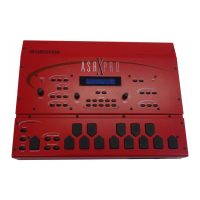Insert Effect Parameters
48 ENSONIQ ASR-X Pro UserÕs Guide
PreVCF EnvAmt -99% to +99% Determines how much the amplitude of the incoming
signal will modify the distortion filter cutoff frequency.
When set to 0, no modification will occur. When set to
mid positive values, the Pre-VCF Fc will go high, but
then come down to its nominal setting. When set to
negative mid values, the Pre-VCF Fc will go low, and
then go back up to its nominal setting. How quickly it
does so is determined by the Attack and Release
parameters. This sound is the auto-wah. Positive values
will boost the high frequencies, and negative values will
cut the high frequencies.
Dist Gain Off, -49.5dB to +48dB Controls the gain going into the distortion effect. This
will boost the signal level up to 48 dB. For more
distortion, use a high input level gain and turn the
distortion volume down to keep the volume under
control. For less distortion, use a low gain input level
and a higher output volume.
Dist Volume Off, -99dB to 0.0dB Controls the volume of the distortion effect. Generally, if
the distortion gain is set high, set this parameter lower.
Distortion Off, On Chooses between distorted and clean signals.
Post VCF Fc 10Hz to 7.10kHz Determines the second distortion filter cutoff frequency.
Higher values have a brighter sound. This parameter
can be modulated by any continuous MIDI controller for
a wah-wah pedal effect.
Post VCF Q 1.0 to 40.0 Determines the level and width of the resonant peak at
the filter cutoff point. While the Fc (filter cutoff)
parameter determines where (at what frequency) this
peak will occur, this parameter controls the sharpness of
the peak.
PostVCF
EnvAmt
-99% to +99% Determines how much the amplitude of the incoming
signal will modify the distortion filter cutoff frequency.
When set to 0, no modification will occur. When set to
mid positive values, the Pre-VCF Fc will go high, but
then come down to its nominal setting. When set to
negative mid values, the Pre-VCF Fc will go low, and
then go back up to its nominal setting. How quickly it
does so is determined by the Attack and Release
parameters.
VCF Attack 50us to 10.0s Sets the attack of the envelope follower (i.e., determines
how closely the attack is followed) once the incoming
signal has been detected. Generally the attack should be
short.
VCF Release 50usto 10.0s Sets the amount of time after the incoming signal has
ceased for the envelope follower to shut down.
Generally these times are longer than the attack times.
Post HPF Fc 10Hz to 1.50kHz Filters out the low frequencies after the distortion.
22
22
99
99
RR
RR
ee
ee
ss
ss
VV
VV
CC
CC
FF
FF
→DD
DD
DD
DD
LL
LL
ResVCF→DDL combines a voltage control filter and a digital delay.
PP
PP
aa
aa
rr
rr
aa
aa
mm
mm
ee
ee
tt
tt
ee
ee
rr
rr
RR
RR
aa
aa
nn
nn
gg
gg
ee
ee
DD
DD
ee
ee
ss
ss
cc
cc
rr
rr
ii
ii
pp
pp
tt
tt
ii
ii
oo
oo
nn
nn
VCF Input Off, -49.5dB to 0.0dB Acts as a trim control at the input of the VCF.
VCF Fc 10Hz to 7.10kHz Determines the VCF cut off frequency. Higher values
have a brighter sound. This parameter can be modulated
by any continuous MIDI controller for a wah wah pedal
effect.
VCF Q 1.0 to 40.0 Determines the level and width of the resonant peak at
the filter cutoff point. While the Fc (filter cutoff)
parameter determines where (at what frequency) this
peak will occur, the Q setting controls the sharpness of
the peak.
ADSR Attack 50us to 10.0s Sets the attack time for the ADSR envelope shape.
ADSR Decay 50us to 10.0s Sets the decay time for the ADSR envelope shape.

